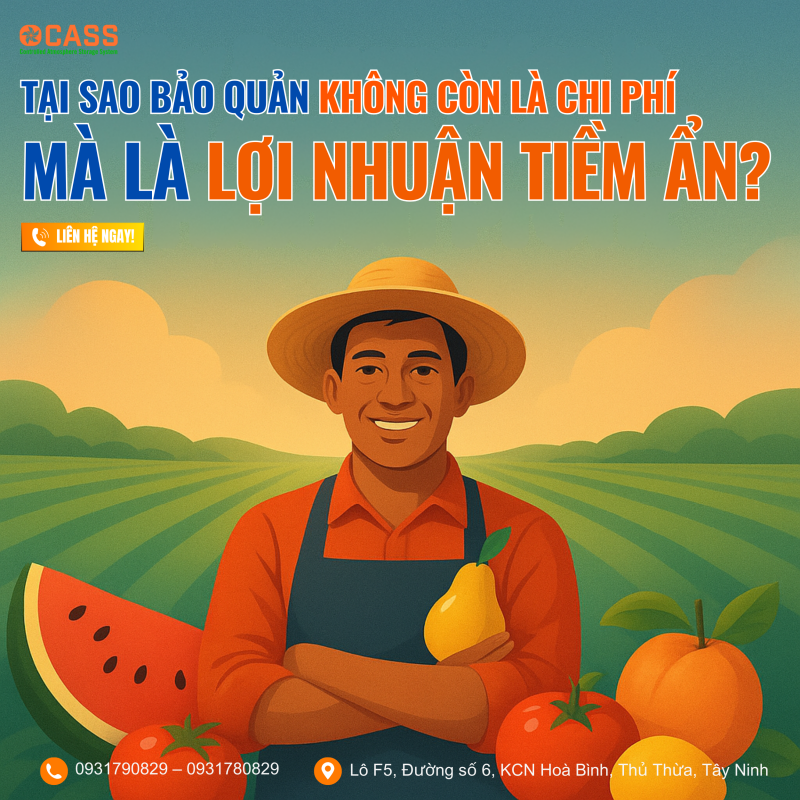For many years, post-harvest preservation has been seen merely as an unavoidable expense. Farmers, cooperatives, and businesses often treated preservation as a “damage control” activity with a cost-cutting mindset. As a result, investments in storage and preservation were limited, leading to significant losses in both volume and quality.
According to FAO, post-harvest losses in agricultural products can range from 20 – 45%, with preservation being one of the key factors. If seen as a cost, saving one unit of investment in preservation could actually result in the loss of ten units in product value.
Today, preservation has moved beyond “maintaining condition” to becoming a tool for value creation. This shift is reflected in three key aspects:
- Extending Market Timing (Time Value):
With modern preservation technology, fresh produce can remain in optimal condition for weeks or even months. This prevents businesses from being forced to sell at low prices during peak harvest seasons, allowing them to strategically release products when the market price is higher. - Ensuring Consistent Quality (Quality Value):
Advanced preservation methods not only keep produce fresh but also maintain nutritional value, flavor, color, and texture. Consistent quality strengthens brand reputation and enhances access to demanding export markets. - Reducing Losses and Hidden Costs (Loss Reduction):
Every percentage of post-harvest loss reduced translates directly into profit retention. Businesses also cut down on logistics inefficiencies, operational risks, and the likelihood of product returns or price cuts from buyers.
=> In other words, modern preservation should be seen as an investment with returns, not merely as an operating expense.
____________
CASS (Controlled Atmosphere Storage System) is a clear example of how preservation can be transformed into profit.
- Optimizing Product Lifecycle:
By adjusting levels of O₂, CO₂, and N₂ inside storage chambers, CASS slows down the respiration process of fruits and vegetables. This extends shelf life significantly compared to conventional storage methods. - Meeting Export Standards:
CASS technology has already been adopted in demanding markets such as Japan, South Korea, and the EU. Maintaining quality that meets international standards enables businesses to expand their export opportunities and increase product value. - Creating Competitive Advantage:
By minimizing post-harvest losses, maintaining quality, and controlling sales timing, businesses using CASS not only reduce risks but also maximize profits. In many cases, the additional revenue from higher selling prices far outweighs the initial preservation costs.
In today’s agricultural value chain, preservation is no longer just a mandatory cost, but a strategic lever for profit growth, brand building, and market expansion.
CASS represents this paradigm shift — moving from “keeping produce from spoiling” to “optimizing value.” Businesses that embrace preservation as a profit-generating investment will secure long-term competitive advantages in the global marketplace.
CÔNG TY TNHH BẢO QUẢN RAU QUẢ CASS
• Hotline/Zalo: 0931790829 – 0931780829
• Email: cass@cass.vn
• Website: cass.vn
• Fanpage: CASS – Kho bảo quản nông sản tươi bằng công nghệ CA
• Địa chỉ kho (trước sáp nhập): Lô F5, Đường số 6, KCN Hoà Bình, Huyện Thủ Thừa, Tỉnh Long An
Địa chỉ kho (sau sáp nhập): Lô F5, Đường số 6, KCN Hoà Bình, Xã Thủ Thừa, Tỉnh Tây Ninh




